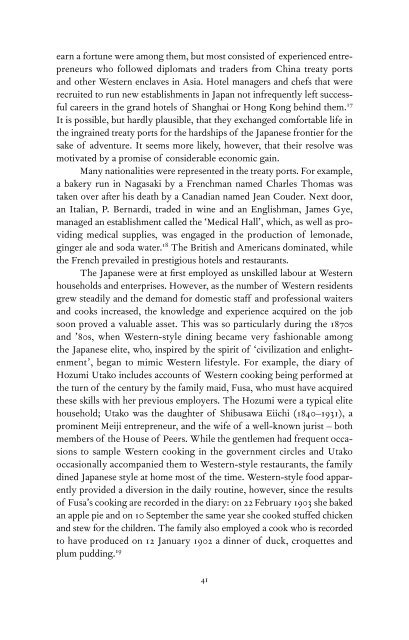Download - Brainshare Public Online Library
Download - Brainshare Public Online Library
Download - Brainshare Public Online Library
Create successful ePaper yourself
Turn your PDF publications into a flip-book with our unique Google optimized e-Paper software.
earn a fortune were among them, but most consisted of experienced entrepreneurs<br />
who followed diplomats and traders from China treaty ports<br />
and other Western enclaves in Asia. Hotel managers and chefs that were<br />
recruited to run new establishments in Japan not infrequently left successful<br />
careers in the grand hotels of Shanghai or Hong Kong behind them. 17<br />
It is possible, but hardly plausible, that they exchanged comfortable life in<br />
the ingrained treaty ports for the hardships of the Japanese frontier for the<br />
sake of adventure. It seems more likely, however, that their resolve was<br />
motivated by a promise of considerable economic gain.<br />
Many nationalities were represented in the treaty ports. For example,<br />
a bakery run in Nagasaki by a Frenchman named Charles Thomas was<br />
taken over after his death by a Canadian named Jean Couder. Next door,<br />
an Italian, P. Bernardi, traded in wine and an Englishman, James Gye,<br />
managed an establishment called the ‘Medical Hall’, which, as well as providing<br />
medical supplies, was engaged in the production of lemonade,<br />
ginger ale and soda water. 18 The British and Americans dominated, while<br />
the French prevailed in prestigious hotels and restaurants.<br />
The Japanese were at first employed as unskilled labour at Western<br />
households and enterprises. However, as the number of Western residents<br />
grew steadily and the demand for domestic staff and professional waiters<br />
and cooks increased, the knowledge and experience acquired on the job<br />
soon proved a valuable asset. This was so particularly during the 1870s<br />
and ’80s, when Western-style dining became very fashionable among<br />
the Japanese elite, who, inspired by the spirit of ‘civilization and enlightenment’,<br />
began to mimic Western lifestyle. For example, the diary of<br />
Hozumi Utako includes accounts of Western cooking being performed at<br />
the turn of the century by the family maid, Fusa, who must have acquired<br />
these skills with her previous employers. The Hozumi were a typical elite<br />
household; Utako was the daughter of Shibusawa Eiichi (1840–1931), a<br />
prominent Meiji entrepreneur, and the wife of a well-known jurist – both<br />
members of the House of Peers. While the gentlemen had frequent occasions<br />
to sample Western cooking in the government circles and Utako<br />
occasionally accompanied them to Western-style restaurants, the family<br />
dined Japanese style at home most of the time. Western-style food apparently<br />
provided a diversion in the daily routine, however, since the results<br />
of Fusa’s cooking are recorded in the diary: on 22 February 1903 she baked<br />
an apple pie and on 10 September the same year she cooked stuffed chicken<br />
and stew for the children. The family also employed a cook who is recorded<br />
to have produced on 12 January 1902 a dinner of duck, croquettes and<br />
plum pudding. 19<br />
41







